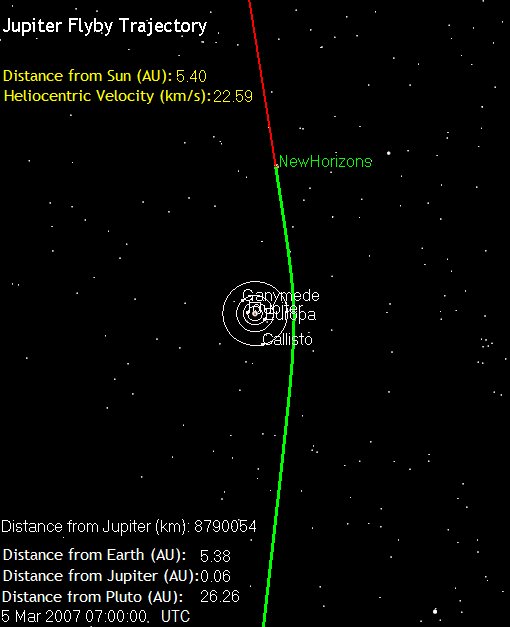by Astrogator Mike | Sep 27, 2011 | General Comments
A twitter friend @musicscott emailed me a picture he had taken Friday night of a region of the sky near Ursa Minor. In his picture he had a streak that he thought may have been a piece of the UARS satellite.
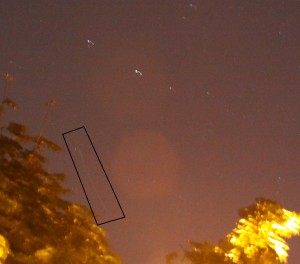
Streak near Ursa Minor provided by @musicscott
He provided me with the original as well:
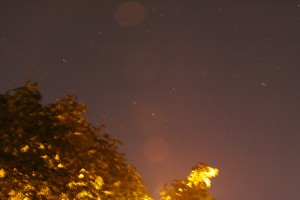
The second image is really interesting, because it shows us the entire “little dipper” so we can really get a feel for where happened. Note that there’s some “jiggle” in the star images because Scott didn’t have time to set the timer on his camera, he had to hit the button manually and that shakes things a bit.
As it turns out, Scott knew very precisely when he took the picture (4:17:11 UTC), so with his help I looked into it. He gave me his precise location and time and managed to get a whole constellation into the picture. Here’s the email I sent him when I figured out what he had seen..
(more…)
by Astrogator Mike | Sep 25, 2011 | General Comments
I’ve seen lots of hocus-pocus out there on where the UARS spacecraft re-entered. Lots of bogus videos are out along with vague descriptions of where the spacecraft landed (some that narrow it down to the Pacific Ocean). While NASA’s taking their time giving us an impact point, they are giving us enough information to calculate one ourselves. Thus, I will take the liberty of doing so. I’ll say a few things about it and then take a wild flying guess (WFG) at where it hit in the ocean based on the few pieces of information we do have.
(more…)
by Astrogator Mike | Sep 24, 2011 | General Comments
I wanted to revisit the previous post, describing a near miss of ISS I witnessed back in August. Recall that both my brother and I saw the same 2 satellites cross in the sky at the same time.
First, let’s just take a look at the geometry that allows satellites to be seen in the first place. If you’re going to see a satellite from the ground, it needs to be lit (by the sun) and you need to be in shadow (night). Here’s a picture of the geometry from my location on Aug. 29, 2011.

Orbit Geometry and Earth Shadow for an ISS pass on Aug. 29, 2011
The red cylinder off to the right is the shadow, the Sun is off to the left. A little closer look allows us to see what’s happening. The two satellites (ISS in the blue, SL rocket body in the red) have orbits that are above the shadow. Note that Friday Harbor and Seattle are both in darkness.
(more…)
by Astrogator Mike | Aug 30, 2011 | General Comments
Is it possible that my brother and I simultaneously witnessed a potentially deadly close approach of the International Space Station from the ground? It’s not clear, but it has been interesting putting together the evidence.
I live north-northwest of Seattle, WA. in Friday Harbor, on San Juan Island (in the US). On Sunday the 28th of August, I saw an ISS pass from my house that started at 21:02 Local (Aug 29 2013 4:02 UTC). Prior to the beginning of the pass, I had called my brother who lives down in Seattle (about 65 miles as the crow flies). He hadn’t seen an ISS pass before, and this one looked to be pretty bright (-3.5 mag, according to the Heavens Above website). He called me on his cell phone during the pass, and we talked as we watched it. Near the end of the pass, I saw another satellite come from the north, and appear to run right through the ISS. My brother noted the same thing to me on the phone, wondering out loud if “someone is trying to shoot it down”. He was joking, but that is what it looked like from our different vantage points.
(more…)
by John Carrico | Jun 25, 2011 | General Comments
For the whole story, check out the June 24th, 2011 mission update by Dave McComas on the Official IBEX Web Site (ibex.swri.edu) .
The real challenge was to find an orbit that we could control for a long time. The original orbit could only be predicted for about 3 years. Cislunar space is a crazy place to try and fly a long-term trajectory; the slightest change in initial conditions can cause completely different trajectories years later. Because IBEX’s original orbit was often closer to the Moon than to the Earth, it was performing gravity assists regularly. The uncertainty in our initial conditions from orbit estimation knowledge and attitude re-pointing maneuvers would cause nearly identical trajectory predictions to eventually experience different gravity assist geometries, and the slightest change in that geometry during the encounter causes huge differences in the subsequent trajectory. Some predictions would hit the Earth (not a good thing for most space missions, by the way) and others would escape the Earth-Moon system (great for science, but not so good for communicating with a spacecraft designed to stay close to Earth.) Our new orbit keeps the apogee away from the Moon and has reduced the sensitivities. We can now predict this trajectory well beyond 11 years now so we can get the full Solar Cycle.
Here is our original trajectory in an Earth-centered Inertial (Mean Earth Equator and Mean Equinox of J2000.0) Coordinate system:
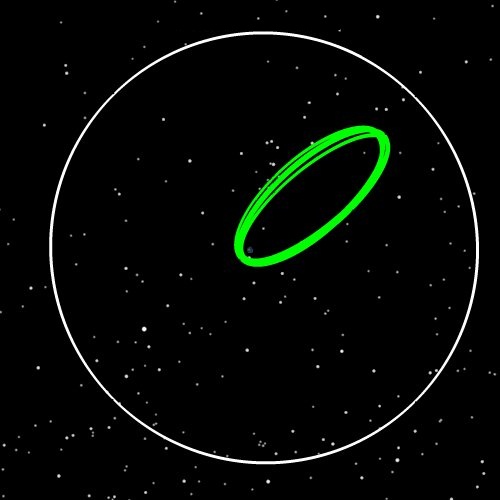
Original IBEX orbit at the beginning of nominal operations
The Earth is hard to see, but it is in the center, and the white circle is the Moon’s orbit. Now here it is in the Earth-Moon Rotating coordinate system; note the apogees that come close to the Moon:
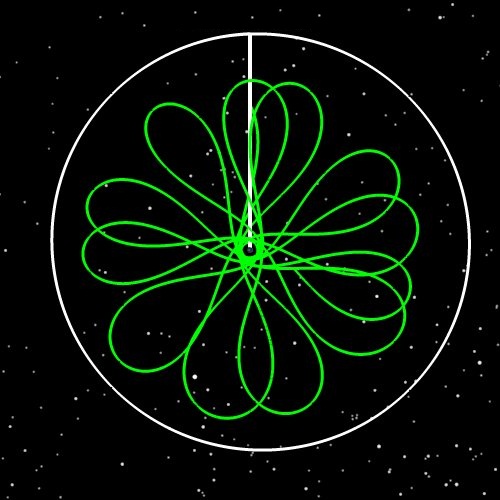
The Original IBEX orbit shown in the Earth-Moon Rotating System
In this rotating system the Earth and the Moon are both pretty much fixed (although the Moon moves up and down a bit because of its orbit’s eccentricity). The Earth is still in the center, and the Moon at the top of the white circle. The white line connects the Earth to the Moon (Don’t look for that with your telescope).
Here is our new orbit in Earth Inertial – not really all that different from the original (just a slightly larger semi-major axis and higher radius of perigee):

The new IBEX Orbit in Earth-centered Inertial coordinates
And here it is in the Earth-Moon rotating frame:

The new IBEX orbit in Earth-Moon Rotating Coordaintes
Note that the apogees stay far away from the Moon, so the gravity assists are much weaker. The spacecraft is always very near perigee when it crosses the Earth-Moon line. (And, no, the spacecraft trajectory is not perturbed by that big white line.)
For more information on the IBEX Flight Dynamics, check out the white papers at the Applied Defense Solutions website.
by Astrogator Mike | Jun 25, 2011 | General Comments

IBEX Earth-Moon Rotating Frame 10-year Trajectory
John and I tried to get the IBEX folks to go for this in 2007, but it was too late in the game to change the science orbit. After 2.5 years of nominal ops (and a whole lot of analysis by John and his team at Applied Defense Solutions) the IBEX science team decided to go for it and use a 3:1 Lunar resonant orbit. A 3:1 Resonance, of course, means simply that IBEX orbits 3 times for every Lunar orbit. There are some very nice things about this, the first being that you can keep apogee away from the Moon, and prevent Lunar perturbations from driving your perigee into the Earth. You can also keep the geometry of the orbit constant with respect to the ecliptic and keep Earth shadows off the orbit for most of the time. John will come back later with pictures and some more details. It really is a neat orbit. My good friend Chauncey Uphoff used to love to talk about resonant orbits and all their uses. He’d love this!
This animation shows the IBEX orbit in an Earth-Moon rotating frame. The Moon is at the top, Earth in the Middle. Note that the Apogees are away from the Earth-Moon line.
by John Carrico | Mar 4, 2007 | General Comments
If you hadn’t heard, the entire trajectory to Pluto (New Horizons) was planned and is being flown by Astrogator. They just passed Jupiter (gravity assist) and are on their way to Pluto. They took a ton on of images as they passed.
Good job everyone!
Also remember, it’s the fastest thing ever built by man! only nine hours from the Earth to the Moon when it launched!
After they plan a maneuver they check it with JPL trajectory software and things are going perfectly!
Here’s the home page with a screen snap from STK:
New Horizons home page
New Horizons animation
Some links from the New Horizons home page:
Pluto-Bound New Horizons Spacecraft Gets a Boost from Jupiter
Tvashtar’s Plume
Europa
Little Red Spot
Fyi, they also do the maneuver planning for Messenger with Astrogator. JPL’s CATO is used for the multiple gravity assist trajectory design, and the high-fidelity maneuver planning and gravity assists are planned with Astrogator. See Messenger
There are lot’s of STK animations there, too!
John
by Astrogator Mike | Jan 26, 2007 | General Comments
We are starting to upload the latest 8.0 scenarios, both from Training and from the tutorials. Over the next several weeks, most of the files will be uploaded in the 8.0 VDF format, which allows both the scenarios to be viewed by users with the free viewer App, but also to be opened by users with Astrogator licenses.








